Optimization of Nonlinear Lamb Wave Detection System Parameters in CFRP Laminates
Abstract
1. Introduction
2. Experimental Study
2.1. Experimental Setup
2.2. Response Surface Model Experimental Design
2.3. Calculation of the Ultrasonic Nonlinear Parameter and Relative Error
3. Experimental Work
3.1. Nonlinear Lamb Wave Detection
3.2. Single-Factor Experiment
3.3. Response Surface Model Analysis
4. Results and Discussion
5. Conclusions
Author Contributions
Funding
Institutional Review Board Statement
Informed Consent Statement
Data Availability Statement
Conflicts of Interest
References
- Hegde, S.; Shenoy, B.S.; Chethan, K.N. Review on carbon fiber reinforced polymer (CFRP) and their mechanical performance. Mater. Today Proc. 2019, 19, 658–662. [Google Scholar] [CrossRef]
- Rajkumar, D.; Jeyaprakash, N.; Yang, C.H.; Sivasankaran, S. Optimization of Drilling Process on Carbon-Fiber Reinforced Plastics Using Genetic-Algorithm. Surf. Rev. Lett. 2021, 28, 2050056. [Google Scholar]
- Karataş, M.A.; Gökkaya, H. A review on machinability of carbon fiber reinforced polymer (CFRP) and glass fiber reinforced polymer (GFRP) composite materials. Defin. Technol. 2018, 14, 318–326. [Google Scholar] [CrossRef]
- Forintos, N.; Czigany, T. Multifunctional application of carbon fiber reinforced polymer composites: Electrical properties of the reinforcing carbon fibers—A short review. Compos. Part B Eng. 2019, 162, 331–343. [Google Scholar] [CrossRef]
- Guo, J.G.; Gao, X.R.; Toma, E.; Netzelmann, U. Anisotropy in carbon fiber reinforced polymer (CFRP) and its effect on induction thermography. NDT E Int. 2017, 91, 1–8. [Google Scholar] [CrossRef]
- Haider, M.F.; Yasmeen, F.; Haider, M.M. Micromechanics model for predicting anisotropic electrical conductivity of carbon fiber composite materials. AIP Conf. Proc. 2016, 1754, 3790–3797. [Google Scholar]
- Rozylo, P.; Ferdynus, M.; Debski, H.; Samborski, S. Progressive Failure Analysis of Thin-Walled Composite Structures Verified Experimentally. Materials 2020, 13, 1138. [Google Scholar] [CrossRef]
- Fabbrocino, F.; Funari, M.F.; Greco, F. Dynamic crack growth based on moving mesh method. Compos. Part B Eng. 2019, 174, 107053. [Google Scholar] [CrossRef]
- Alabtah, F.G.; Mahdi, E. The effect of sizing optimization on the interface between high strength steel and fiber reinforced composite. Compos. Struct. 2021, 113740. [Google Scholar] [CrossRef]
- Hu, C.; Huang, G.; Li, C. Experimental and Numerical Study of Low-Velocity Impact and Tensile after Impact for CFRP Laminates Single-Lap Joints Adhesively Bonded Structure. Materials 2021, 14, 1016. [Google Scholar] [CrossRef]
- Gliszczynski, A.; Bogenfeld, R.; Degenhardt, R.; Kubiak, T. Corner impact and compression after impact (CAI) of thin-walled composite profile-an experimental study. Compos. Struct. 2020, 248, 112502. [Google Scholar] [CrossRef]
- Zhu, Y.; Zeng, X.; Deng, M. Mode selection of nonlinear lamb wave based on approximate phase velocity matching. NDT E Int. 2019, 102, 295–303. [Google Scholar] [CrossRef]
- Solodov, I.; Wackerl, J.; Pfleiderer, K. Nonlinear self-modulation and subharmonic acoustic spectroscopy for damage detection and location. Appl. Phys. Lett. 2004, 84, 5386–5388. [Google Scholar] [CrossRef]
- Li, W.B.; Xu, Y.R.; Hu, N. Impact damage detection in composites using a guided wave mixing technique. Meas. Sci. Technol. 2020, 31, 014001. [Google Scholar] [CrossRef]
- She, H.; Li, C.; Tang, Q. Veering and merging analysis of nonlinear resonance frequencies of an assembly bladed disk system. J. Sound Vib. 2021, 493, 115818. [Google Scholar] [CrossRef]
- Yelve, N.P.; Mitra, M.; Mujumdar, P.M. Detection of stiffener disbonding in a stiffened aluminium panel using nonlinear Lamb wave. Appl. Acoust. 2015, 89, 267–272. [Google Scholar] [CrossRef]
- Sun, X.; Liu, X.; Liu, Y. Simulations on Monitoring and Evaluation of Plasticity-Driven Material Damage Based on Second Harmonic of S0 Mode Lamb Waves in Metallic Plates. Materials 2017, 10, 827. [Google Scholar] [CrossRef]
- Li, W.B.; Hu, S.; Deng, M.X. Combination of Phase Matching and Phase-Reversal Approaches for Thermal Damage Assessment by Second Harmonic Lamb Waves. Materials 2018, 11, 1961. [Google Scholar] [CrossRef] [PubMed]
- Cantrell, J.H.; Yost, W.T. Nonlinear ultrasonic characterization of fatigue microstructures. Int. J. Fatigue 2001, 23, 487–490. [Google Scholar] [CrossRef]
- Dirik, H.; Yalinkaya, T. Crack Path and Life Prediction Under Mixed Mode Cyclic Variable Amplitude Loading Through XFEM. Int. J. Fatigue 2018, 114, 34–50. [Google Scholar] [CrossRef]
- Li, W.B.; Xu, Y.R.; Hu, N. Numerical and experimental investigations on second-order combined harmonic generation of Lamb wave mixing. AIP Adv. 2020, 10, 045119. [Google Scholar] [CrossRef]
- Yang, Y.; Ng, C.T.; Kotousov, A. Second-order harmonic generation of Lamb wave in prestressed plates. J. Sound Vib. 2019, 460, 114903. [Google Scholar] [CrossRef]
- Jiao, J.P.; Meng, X.J.; He, C.F. Nonlinear Lamb wave-mixing technique for micro-crack detection in plates. NDT E Int. 2017, 85, 63–71. [Google Scholar]
- Tie, Y.; Zhang, Q.S.; Hou, Y.L. Impact damage assessment in orthotropic CFRP laminates using nonlinear Lamb wave: Experimental and numerical investigations. Compos. Struct. 2020, 236, 111869. [Google Scholar] [CrossRef]
- Yang, Y.; Ng, C.T.; Kotousov, A. Second harmonic generation at fatigue cracks by low-frequency Lamb waves: Experimental and numerical studies. Mech. Syst. Signal. Process. 2018, 99, 760–773. [Google Scholar] [CrossRef]
- Carboni, M.; Gianneo, A.; Giglio, M.A. Lamb waves based statistical approach to structural health monitoring of carbon fiber reinforced polymer composites. Ultrasonics 2015, 60, 51–64. [Google Scholar] [CrossRef] [PubMed]
- Ramazani, A.; Abbasi, M.; Prahl, U. Failure analysis of DP600 steel during the cross-die test. Comput. Mater. Sci. 2012, 64, 101–105. [Google Scholar] [CrossRef]
- Fekih, S.; Albedah, A.; Benyahia, F.; Belhouari, M.; Bouiadjra, B.B. Optimisation of the sizes of bonded composite repair in aircraft structures. Mater. Design 2012, 41, 171–176. [Google Scholar] [CrossRef]
- Tie, Y.; Hou, Y.L.; Li, C.; Meng, L. Optimization for maximizing the impact-resistance of patch repaired CFRP laminates using a surrogate-based model. Int. J. Mech. Sci. 2020, 172, 105407. [Google Scholar] [CrossRef]
- Liu, H.; Yin, Z.H.; Zhang, Q. Mathematical modeling of bovine hides swelling behavior by response surface methodology for minimization of sulfide pollution in leather manufacture. J. Clean. Prod. 2019, 237, 117800. [Google Scholar] [CrossRef]
- Oberoi, D.P.S.; Sogi, D.S. Utilization of watermelon pulp for lycopene extraction by response surface methodology. Food Chem. 2017, 232, 316–621. [Google Scholar] [CrossRef]
- Zhang, J.F.; Li, S.Y.; Xuan, F.Z. Effect of plastic deformation on nonlinear ultrasonic response of austenitic stainless steel. Mater. Sci. Eng. A 2015, 622, 146–152. [Google Scholar] [CrossRef]
- Jhang, K.Y. Nonlinear ultrasonic techniques for nondestructive assessment of micro damage in material: A review. Int. J. Precis. Eng. Manuf. 2009, 10, 123–135. [Google Scholar] [CrossRef]
- Aslam, M.; Nagarajan, P.; Remanan, M. Defect Localization Using Nonlinear Lamb Wave Mixing Technique. J. Nondestruct. Eval. 2021, 40, 16. [Google Scholar] [CrossRef]
- Amura, M.; Meo, M.; Amerini, F. Baseline-free estimation of residual fatigue life using a third order acoustic nonlinear parameter. J. Acoust. Soc. Am. 2011, 130, 1829–1837. [Google Scholar] [CrossRef]
- Zhao, Y.; Li, F.; Cao, P. Generation mechanism of nonlinear ultrasonic Lamb waves in thin plates with randomly distributed micro-cracks. Ultrasonics 2017, 79, 60–67. [Google Scholar] [CrossRef]
- Hong, M.; Mao, Z.; Todd, M.D. Uncertainty quantification for acoustic nonlinearity parameter in Lamb wave-based prediction of barely visible impact damage in composites. Mech. Syst. Signal. Process. 2017, 82, 448–460. [Google Scholar] [CrossRef]
- Yin, Z.H.; Li, C.; Tie, Y.; Duan, Y.C. Impact Damage Detection in Patch-Repaired CFRP Laminates Using Nonlinear Lamb Waves. Sensors 2021, 21, 219. [Google Scholar] [CrossRef] [PubMed]
- Deming, S.N. Quality by designs part 5. Chemtech 1990, 20, 118–120. [Google Scholar]
- Alaswad, A.; Benyounis, K.Y.; Olabi, A.G. Employment of finite element analysis and Response Surface Methodology to investigate the geometrical factors in T-type bi-layered tube hydroforming. Adv. Eng. Softw. 2011, 42, 917–926. [Google Scholar] [CrossRef]
- Montgomery, D.C. Design and Analysis of Experiments; Springer Texts in Statistics; Springer: Berlin/Heidelberg, Germany, 2017; Volume 101, pp. 853–854. [Google Scholar]

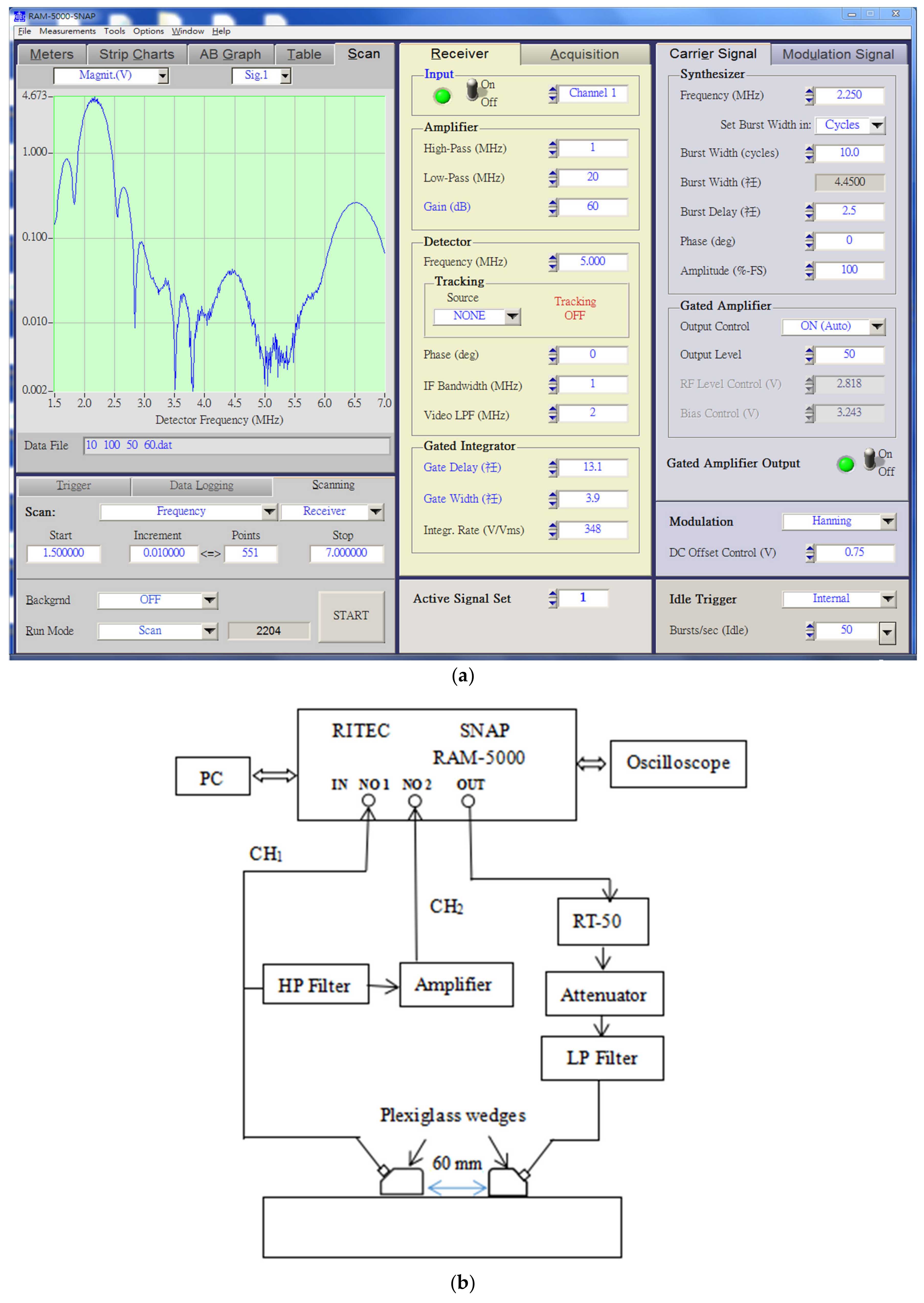
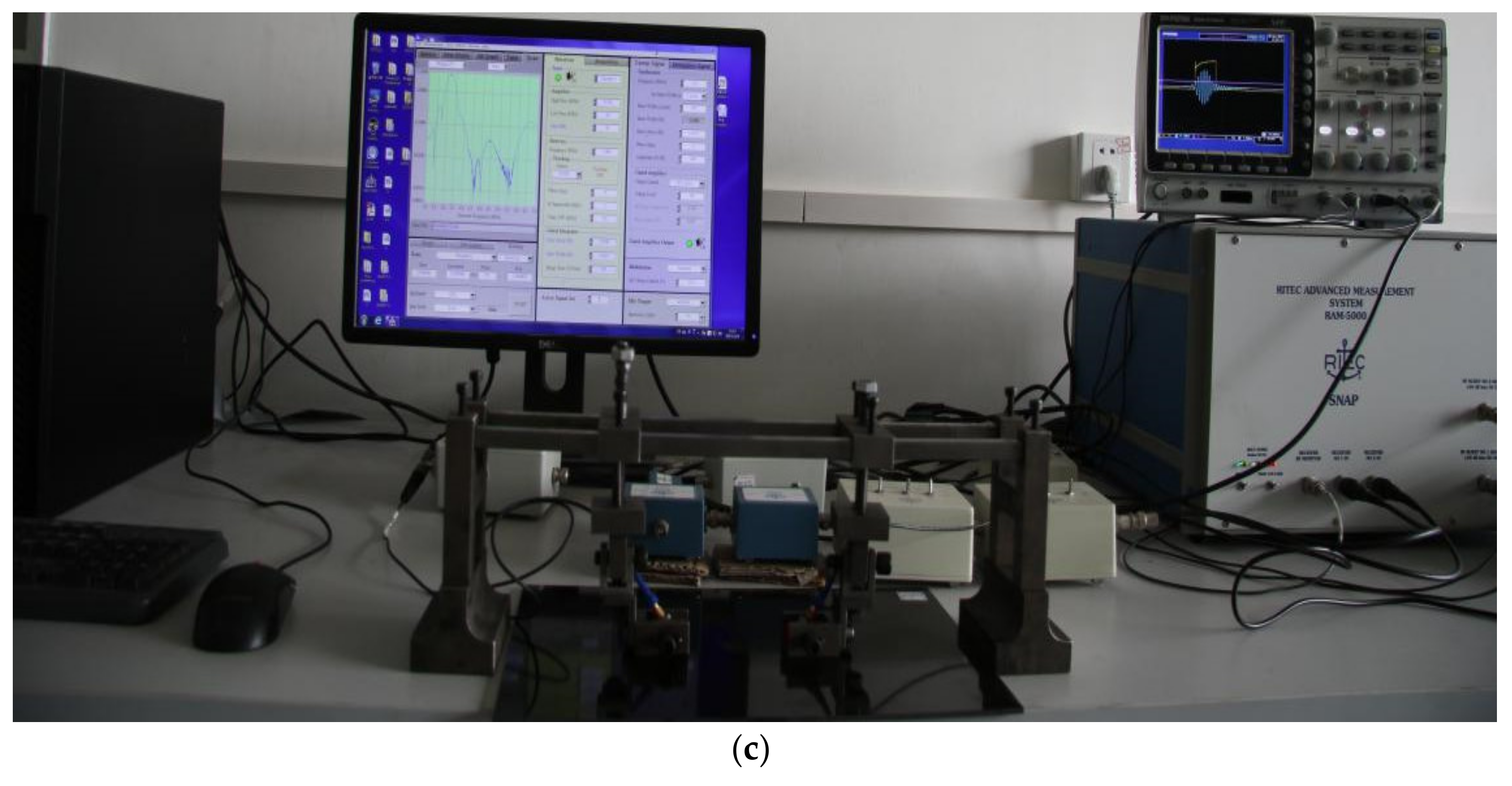
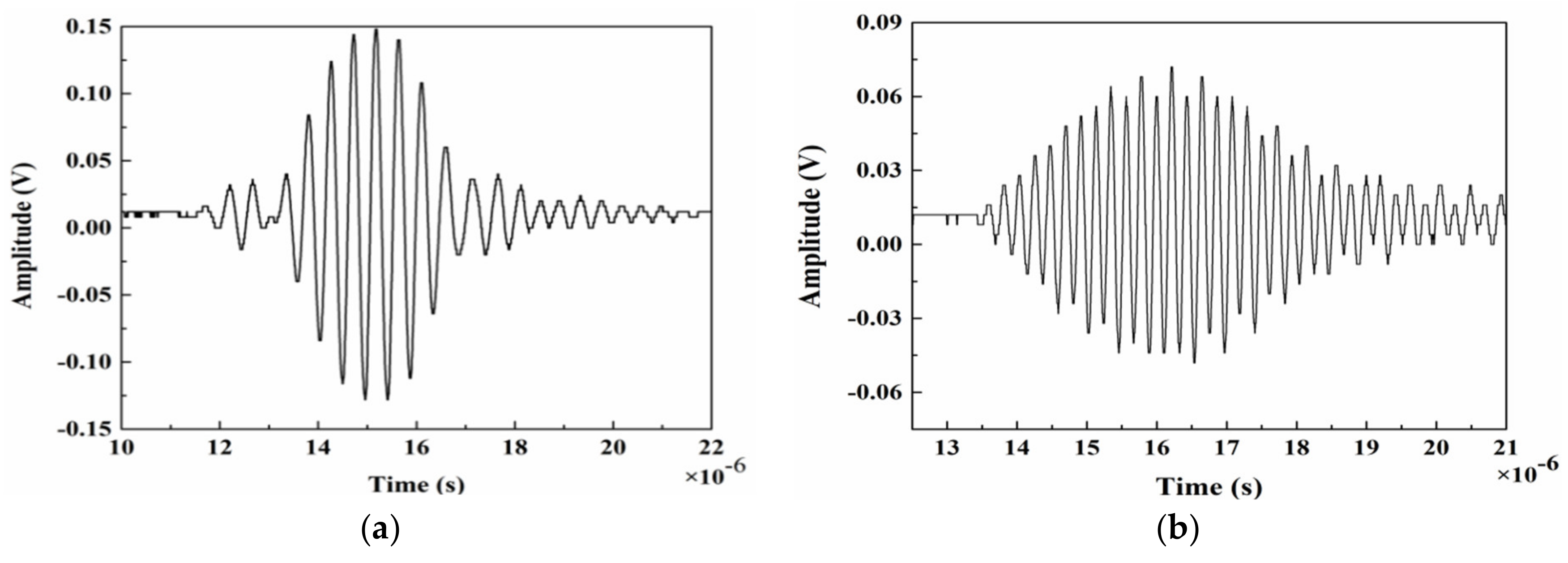

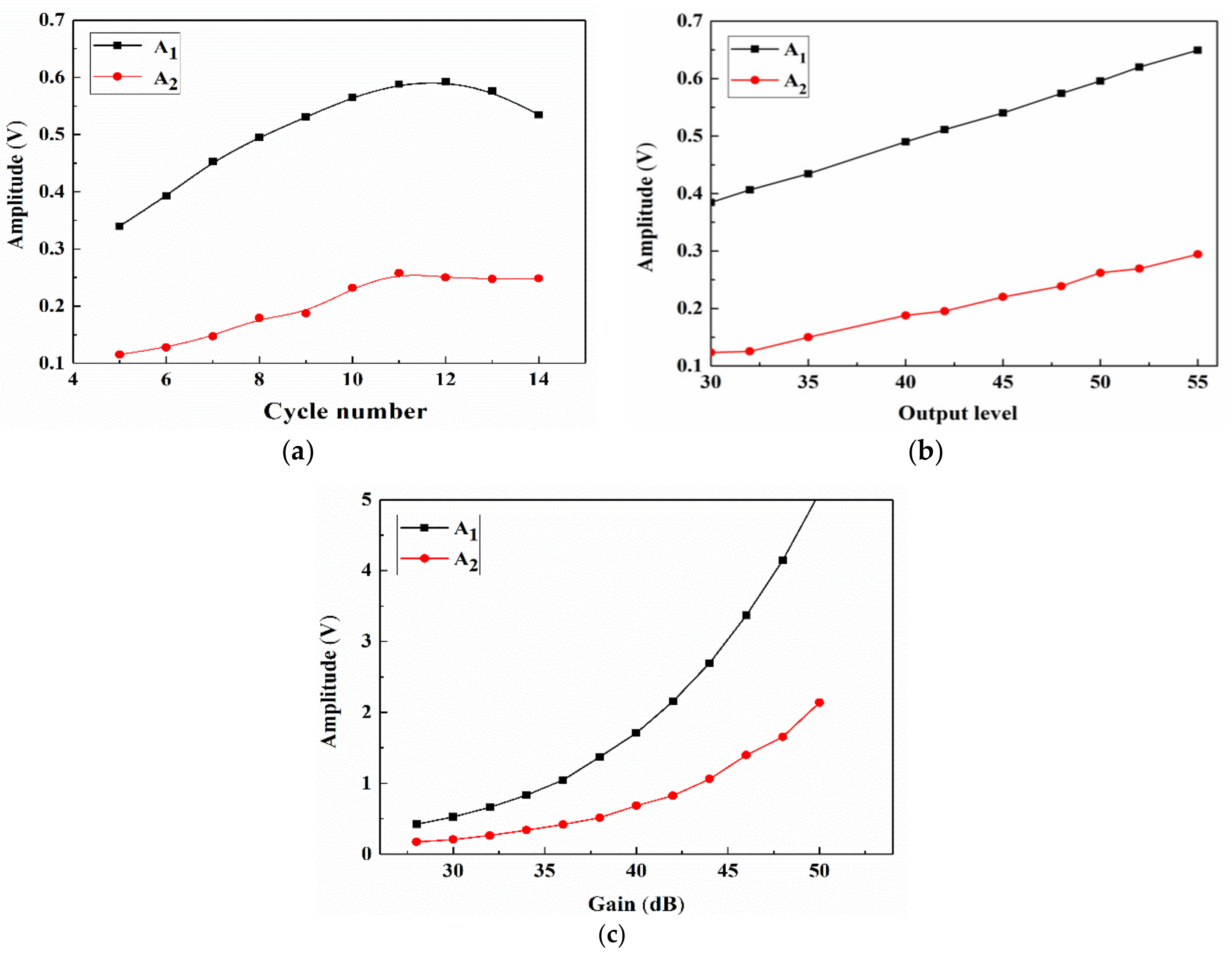

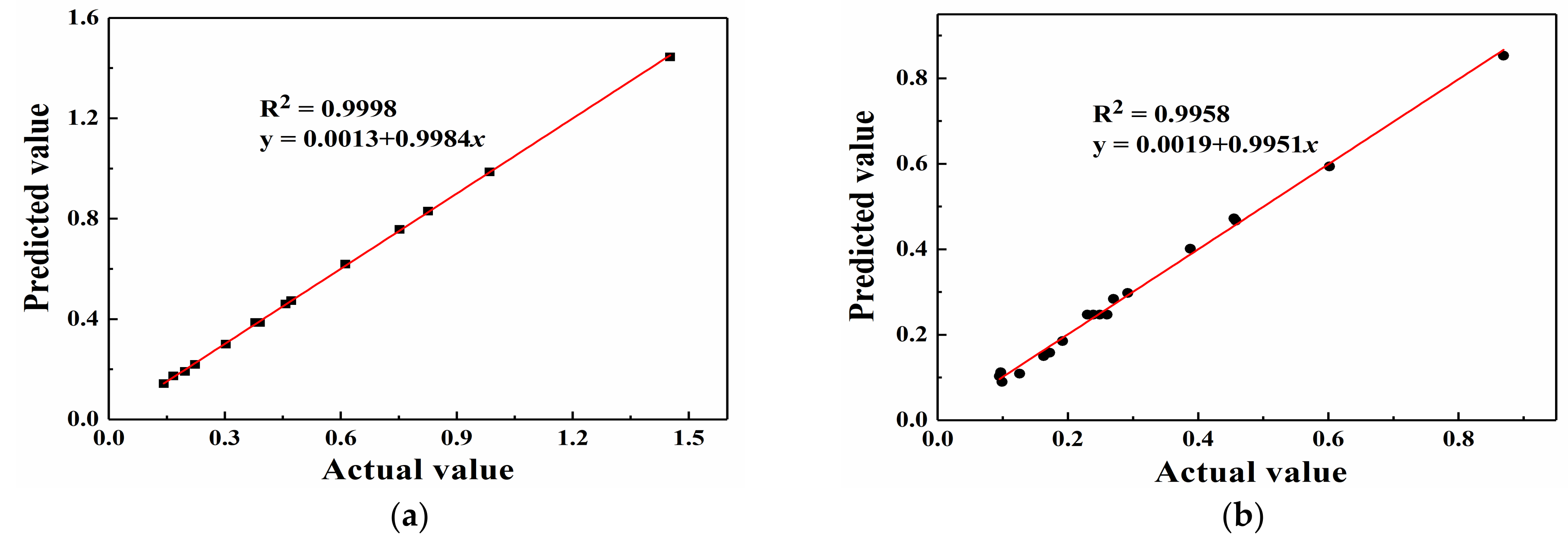


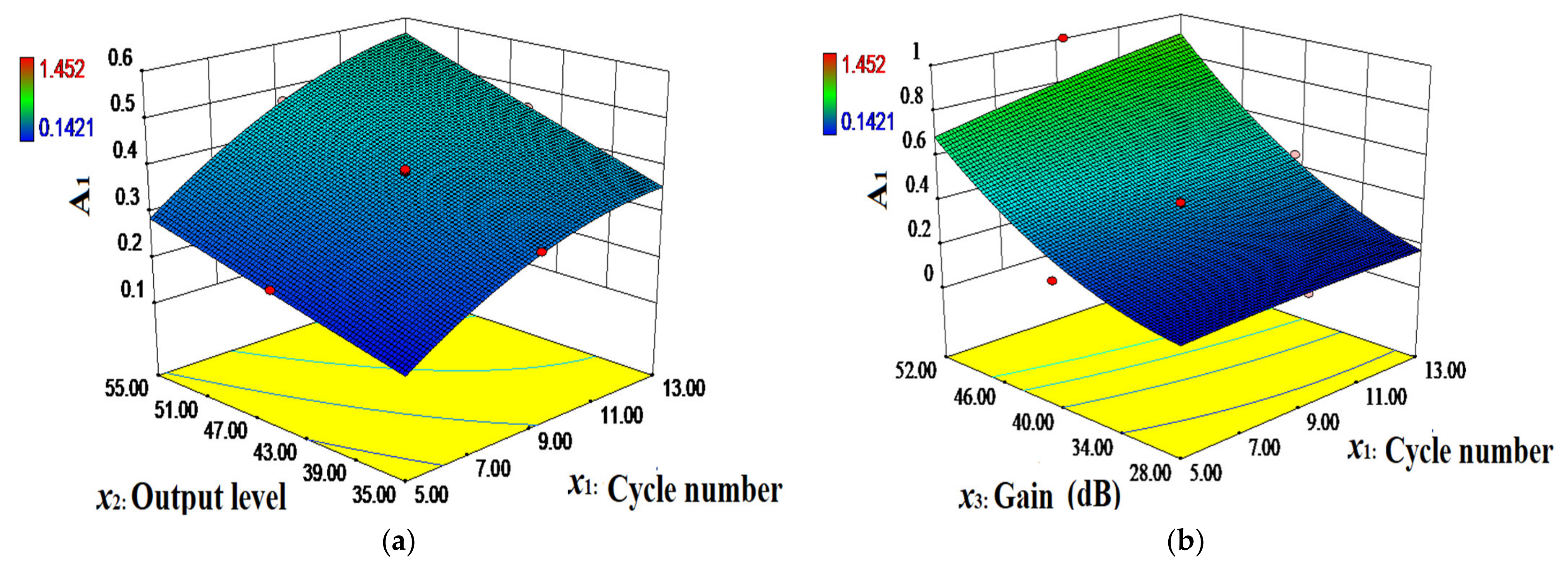
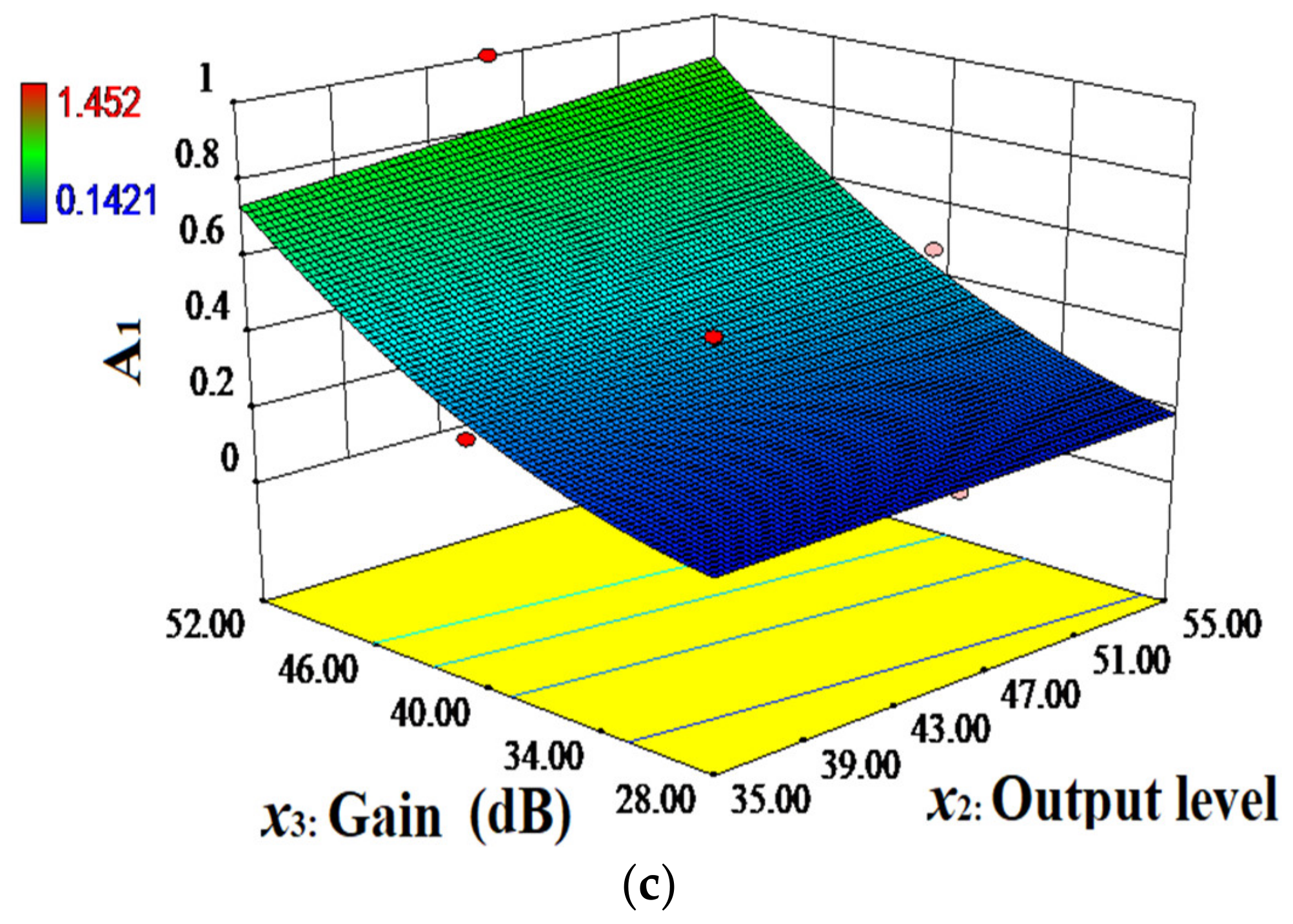
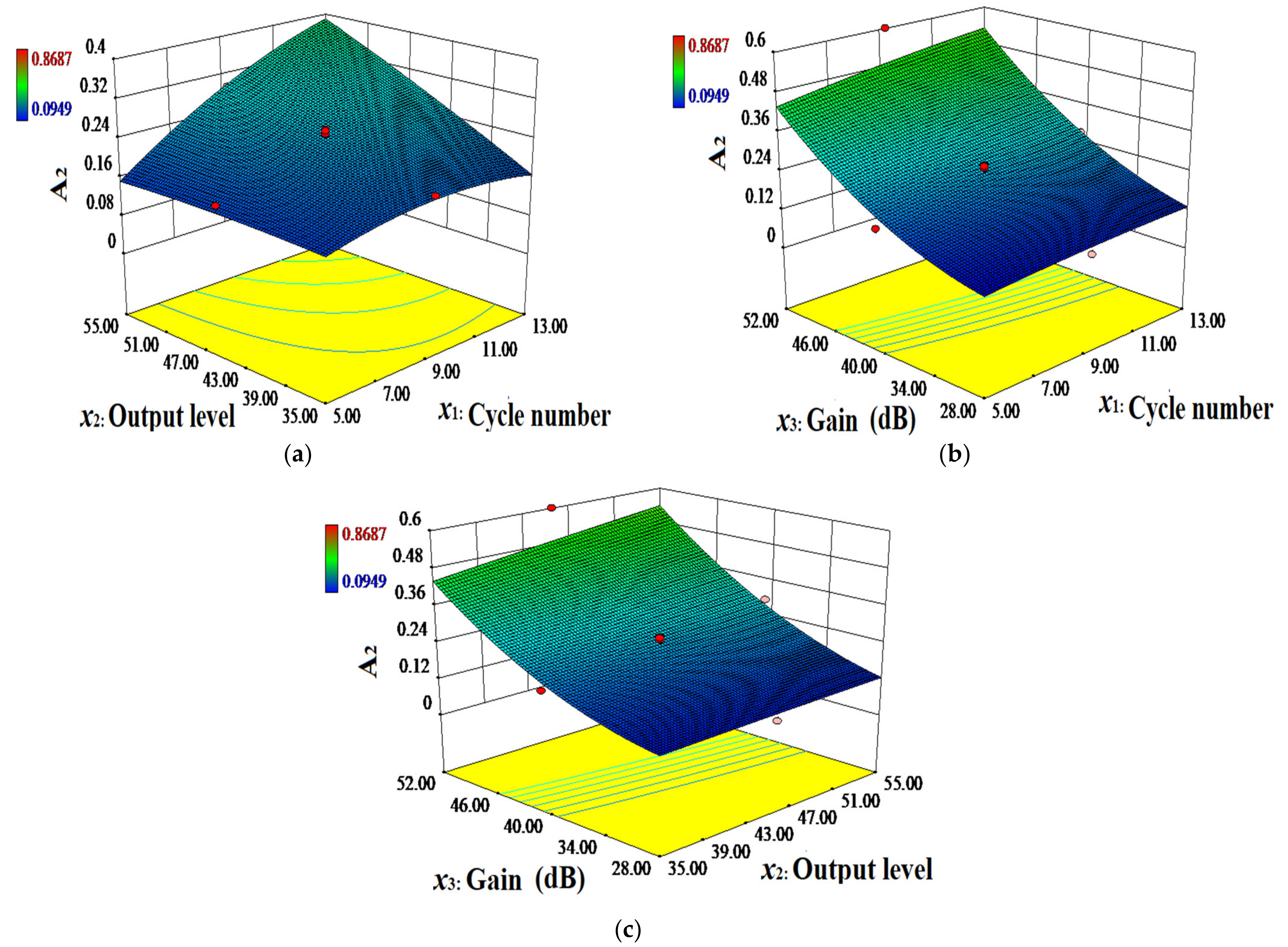
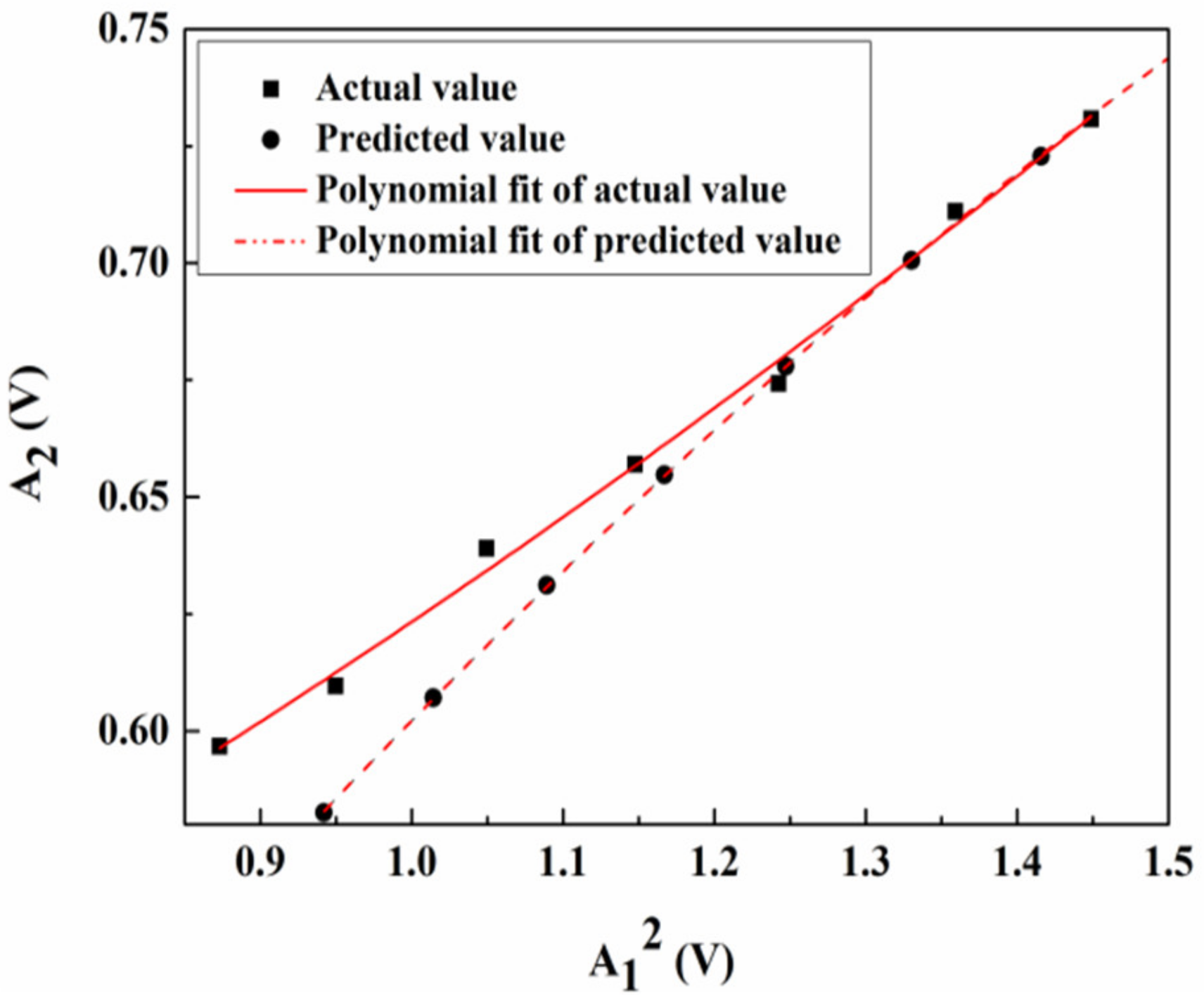
| Factors | Variable | Range and Coded Levels | ||||
|---|---|---|---|---|---|---|
| −2 | −1 | 0 | 1 | 2 | ||
| Cycle number | x1 | 5 | 7 | 9 | 11 | 13 |
| Output level | x2 | 35 | 40 | 45 | 50 | 55 |
| Gain (dB) | x3 | 28 | 34 | 40 | 46 | 52 |
| Run | Coded | Actual | Actual Values (V) | Predicted Values (V) | Relative Errors (%) | |||||||
|---|---|---|---|---|---|---|---|---|---|---|---|---|
| X1 | X2 | X3 | x1 | x2 | x3 | A1 | A2 | A1′ | A2′ | δA1 | δA2 | |
| 1 | −1 | 1 | −1 | 7 | 50 | 34 | 0.1623 | 0.0987 | 0.1602 | 0.0939 | 1.31 | 5.07 |
| 2 | 1 | −1 | 1 | 11 | 40 | 46 | 0.8260 | 0.4583 | 0.8298 | 0.4668 | −0.46 | −1.82 |
| 3 | 1 | −1 | −1 | 11 | 40 | 34 | 0.1598 | 0.1086 | 0.1562 | 0.0997 | 2.30 | 8.97 |
| 4 | 1 | 1 | −1 | 11 | 50 | 34 | 0.1965 | 0.1627 | 0.1912 | 0.1520 | 2.77 | 7.06 |
| 5 | 2 | 0 | 0 | 13 | 45 | 40 | 0.4574 | 0.2695 | 0.4603 | 0.2802 | −0.63 | −3.83 |
| 6 | −1 | 1 | 1 | 7 | 50 | 46 | 0.7521 | 0.4546 | 0.7574 | 0.4673 | −0.70 | −2.72 |
| 7 | 0 | 0 | 0 | 9 | 45 | 40 | 0.3905 | 0.2507 | 0.3863 | 0.2468 | 1.09 | 1.60 |
| 8 | 1 | 1 | 1 | 11 | 50 | 46 | 0.9845 | 0.6019 | 0.9855 | 0.5953 | −0.10 | 1.11 |
| 9 | 0 | 0 | 0 | 9 | 45 | 40 | 0.3787 | 0.2386 | 0.3863 | 0.2468 | −1.97 | −3.31 |
| 10 | 0 | 0 | 0 | 9 | 45 | 40 | 0.3878 | 0.2488 | 0.3863 | 0.2468 | 0.39 | 0.83 |
| 11 | 0 | 2 | 0 | 9 | 55 | 40 | 0.4716 | 0.2918 | 0.4730 | 0.2984 | −0.30 | −2.20 |
| 12 | −1 | −1 | 1 | 7 | 40 | 46 | 0.6122 | 0.3880 | 0.6192 | 0.4025 | −1.13 | −3.60 |
| 13 | 0 | 0 | 0 | 9 | 45 | 40 | 0.3854 | 0.2596 | 0.3863 | 0.2468 | −0.23 | 5.20 |
| 14 | 0 | 0 | −2 | 9 | 45 | 28 | 0.1674 | 0.1066 | 0.1734 | 0.1155 | −3.46 | −7.70 |
| 15 | −1 | −1 | −1 | 7 | 40 | 34 | 0.1421 | 0.0949 | 0.1427 | 0.1053 | −0.42 | −9.85 |
| 16 | 0 | 0 | 0 | 9 | 45 | 40 | 0.3835 | 0.2300 | 0.3863 | 0.2468 | −0.72 | −6.79 |
| 17 | 0 | 0 | 0 | 9 | 45 | 40 | 0.3935 | 0.2567 | 0.3863 | 0.2468 | 1.86 | 4.03 |
| 18 | 0 | 0 | 2 | 9 | 45 | 52 | 1.4520 | 0.8687 | 1.4443 | 0.8560 | 0.53 | 1.48 |
| 19 | −2 | 0 | 0 | 5 | 45 | 40 | 0.2233 | 0.1724 | 0.2187 | 0.1579 | 2.10 | 9.21 |
| 20 | 0 | −2 | 0 | 9 | 35 | 40 | 0.3029 | 0.1916 | 0.2998 | 0.1812 | 1.03 | 5.72 |
| Source | Response A1 | Response A2 | ||||||
|---|---|---|---|---|---|---|---|---|
| Sum of Squares | Mean Square | F-Value | p-Value Probability > F | Sum of Squares | Mean Square | F-Value | p-Value Probability > F | |
| Model | 2.05 | 0.23 | 5498.52 | <0.0001 significant | 0.69 | 0.076 | 353.71 | <0.0001 significant |
| x1-Cycle number | 0.058 | 0.058 | 1409.22 | <0.0001 | 0.015 | 0.015 | 69.31 | <0.0001 |
| x2-Output level | 0.030 | 0.03 | 724.18 | <0.0001 | 0.014 | 0.014 | 63.49 | <0.0001 |
| x3-Gain (dB) | 1.61 | 1.61 | 38998 | <0.0001 | 0.55 | 0.55 | 2538.12 | <0.0001 |
| x1×2 | 1.54 × 10−4 | 1.54 × 10−4 | 3.72 | 0.0827 | 2.03 × 10−3 | 2.03 × 10−3 | 9.38 | 0.0120 |
| x1×3 | 0.019 | 0.019 | 469.29 | <0.0001 | 2.45 × 10−3 | 2.45 × 10−3 | 11.32 | 0.0072 |
| x2×3 | 7.29 × 10−3 | 7.29 × 10−3 | 176.04 | <0.0001 | 2.90 × 10−3 | 2.90 × 10−3 | 13.42 | 0.0044 |
| x12 | 3.44 × 10−3 | 3.44 × 10−3 | 83.01 | <0.0001 | 1.21 × 10−3 | 1.21 × 10−3 | 5.58 | 0.0397 |
| x22 | 2.54 × 10−8 | 2.54 × 10−8 | 6.15 × 10−4 | 0.9807 | 7.61 × 10−5 | 7.61 × 10−5 | 0.35 | 0.5660 |
| x32 | 0.28 | 0.28 | 6776.11 | <0.0001 | 0.09 | 0.09 | 415.42 | <0.0001 |
| Residual | 4.14 × 10−4 | 4.14 × 10−5 | 2.16 × 10−3 | 2.16 × 10−4 | ||||
| Lack of Fit | 2.76 × 10−4 | 5.53 × 10−5 | 2.01 | 0.2314; not significant | 1.53 × 10−3 | 3.06 × 10−3 | 2.44 | 0.1752; not significant |
| Pure Error | 1.38 × 10−4 | 2.75 × 10−5 | 6.28 × 10−4 | 1.26 × 10−4 | ||||
| Cor Total | 2.05 | 0.69 | ||||||
| Response | Standard Deviation | Mean | C.V. (%) | PRESS | R-Squared | Adjusted R-Squared | Predicted R-Squared | Adeq. Precision |
|---|---|---|---|---|---|---|---|---|
| A1 | 6.435 × 10−3 | 0.46 | 1.39 | 2.51 × 10−3 | 0.9998 | 0.9996 | 0.9988 | 286.028 |
| A2 | 0.015 | 0.29 | 5.11 | 0.014 | 0.9969 | 0.9941 | 0.9803 | 73.321 |
| Cycle Number | Output Level | Gain | Actual Values | Predicted Values | Relative Errors | ||||
|---|---|---|---|---|---|---|---|---|---|
| A1 (V) | A2 (V) | A1′ (V) | A2′ (V) | δA1 (%) | δA2 (%) | Δβ′ (%) | |||
| 8 | 36 | 50 | 0.9396 | 0.5967 | 0.9706 | 0.5825 | −3.20 | 1.39 | 8.20 |
| 8 | 36 | 44 | 0.4759 | 0.3207 | 0.4854 | 0.3059 | −1.96 | 4.46 | 8.67 |
| 10 | 52 | 50 | 1.5298 | 0.9222 | 1.4118 | 0.8423 | 8.36 | 9.45 | −6.78 |
| 10 | 48 | 44 | 0.7148 | 0.4355 | 0.7281 | 0.4453 | −1.83 | −2.24 | 1.44 |
| 10 | 46 | 42 | 0.5480 | 0.3394 | 0.5505 | 0.3408 | −0.46 | −0.25 | 0.68 |
| 10 | 38 | 42 | 0.4642 | 0.286 | 0.4617 | 0.2707 | 0.54 | 7.05 | 5.91 |
| 8 | 54 | 30 | 0.1463 | 0.075 | 0.1417 | 0.0672 | 3.25 | −-3.05 | −9.05 |
| 12 | 38 | 44 | 0.6108 | 0.3254 | 0.6607 | 0.3542 | −7.55 | −6.75 | 9.11 |
| 6 | 36 | 44 | 0.3759 | 0.3003 | 0.3767 | 0.2755 | −0.20 | 7.43 | 7.86 |
| 10 | 36 | 42 | 0.4427 | 0.2500 | 0.4395 | 0.2520 | 0.72 | 1.01 | −0.43 |
Publisher’s Note: MDPI stays neutral with regard to jurisdictional claims in published maps and institutional affiliations. |
© 2021 by the authors. Licensee MDPI, Basel, Switzerland. This article is an open access article distributed under the terms and conditions of the Creative Commons Attribution (CC BY) license (https://creativecommons.org/licenses/by/4.0/).
Share and Cite
Yin, Z.; Tie, Y.; Duan, Y.; Li, C. Optimization of Nonlinear Lamb Wave Detection System Parameters in CFRP Laminates. Materials 2021, 14, 3186. https://doi.org/10.3390/ma14123186
Yin Z, Tie Y, Duan Y, Li C. Optimization of Nonlinear Lamb Wave Detection System Parameters in CFRP Laminates. Materials. 2021; 14(12):3186. https://doi.org/10.3390/ma14123186
Chicago/Turabian StyleYin, Zhenhua, Ying Tie, Yuechen Duan, and Cheng Li. 2021. "Optimization of Nonlinear Lamb Wave Detection System Parameters in CFRP Laminates" Materials 14, no. 12: 3186. https://doi.org/10.3390/ma14123186
APA StyleYin, Z., Tie, Y., Duan, Y., & Li, C. (2021). Optimization of Nonlinear Lamb Wave Detection System Parameters in CFRP Laminates. Materials, 14(12), 3186. https://doi.org/10.3390/ma14123186








